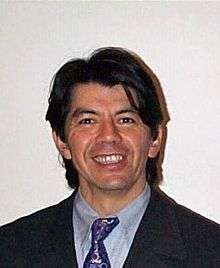Bernard Foing
| Bernard Foing | |
|---|---|
 | |
| Born | France |
| Alma mater | Ecole Normale Supérieure of Education & Technology[1] |
| Known for | Principal Project Scientist for SMART-1 |
| Spouse | Pascale Ehrenfreund |
Bernard Foing is a French scientist at the European Space Agency (ESA),[2] Executive Director of the International Lunar Exploration Working Group (ILEWG)[3] and was Principal Project Scientist for SMART-1, the first European mission to the Moon.[4]
Biography
Born in France,[1] Bernard Foing has a PhD in Astrophysics and Space Techniques.[5] He worked 3 years in Chile as an astronomer for the European Southern Observatory (ESO),[5] the French embassy, and as Professor of Astrophysics.[1] A researcher at French National Centre for Scientific Research (CNRS) since 1986,[6] Foing obtained the Habilitation for direction of research in 1990.[6] At ESA since 1993, he is Senior Research Coordinator at the Research and Scientific Support Department.[5] He was president of ILEWG in 1998-2000 and now is their Executive Director.[5] Foing collaborates with his wife, Pascale Ehrenfreund of the German Aerospace Center, in some of his research.[7]
SMART-1
Foing is known as the father of SMART-1.[3][8] Serving as Principal Project Scientist from conception in 1996,[4] SMART-1 was the first European mission to the Moon.[9] SMART-1's goals were both technological and scientific.[10] First in a series of "Small Missions for Advanced Research in Technology",[10] SMART-1 was used to test new state-of-the art instruments such as a solar-electric primary propulsion system.[11] SMART-1 also performed scientific observations of the Moon including determining the Moon's mineralogical composition and the presence and quantity of water in the craters at the Moon's south pole.[11] Launched on September 27, 2003,[12] SMART-1 entered lunar orbit in November 2004[13] and continued orbit until it was intentionally crashed into the lunar surface on September 3, 2006.[14][15] Said Foing, "SMART-1 data are helping to choose future landing sites for robotic and possible manned missions, and its instruments are upgraded and being flown again on the next generation of lunar satellites."[16]
Mars Express
Foing is an organic chemist for Mars Express,[17] a space exploration mission by the European Space Agency.[18] Launched on June 2, 2004,[19] Mars Express is the first planetary mission attempted by the agency.[18] Foing is also co-investigator of the High Resolution Stereo Camera (HRSC) for the Mars Express orbiter.[20] The HRSC is a high-resolution camera that can make full-color 3-D images of Mars's surface.[21] The camera can also zoom in for a closer look and may be helpful in identifying useful landing sites for future Mars missions.[21]
Bibliography
Foing has published over 400 articles, including 160 refereed papers, in lunar and planetary science and exploration, solar/stellar physics and astrobiology.[1] He edited 16 books and organized over 50 international conferences and symposia.[1]
References
- 1 2 3 4 5 "MDRS: Crew 77 Biographies". The Mars Society. Retrieved 2009-08-29.
- ↑ "Synthesis of SMART-1 lunar results for future exploration | Lunar Science Forum 2009". NASA. Archived from the original on 2009-07-31. Retrieved 2009-08-30.
- 1 2 "Moon Seen as Laboratory for Life". Space.com. Retrieved 2009-08-29.
- 1 2 "Our 8th Continent, the Moon". Japan Aerospace Exploration Agency. Retrieved 2009-08-30.
- 1 2 3 4 "SMART-1 Mission Operations and Lunar Results". China National Space Administration. Archived from the original on 2011-04-02. Retrieved 2009-08-29.
- 1 2 "RSSD - Internal seminars 2006". European Space Agency. Retrieved 2009-08-30.
- ↑ Ehrenfreund, Pascale (8 November 2011). "A Multiple-Choice Essay" (PDF). Astrobiology. 11 (8): 737. doi:10.1089/ast.2011.0697. Retrieved 28 November 2015.
- ↑ Highfield, Roger (2008-04-17). "I'll grow marigolds on the moon, says scientist". The Daily Telegraph. London. Retrieved 2009-08-30.
- ↑ "Europe probe arrives at the Moon". BBC News. 2004-11-16. Retrieved 2009-08-29.
- 1 2 "ESA Portal - United Kingdom - SMART-1: the lunar adventure begins". European Space Agency. Retrieved 2009-08-30.
- 1 2 "ESA Science & Technology: SMART-1". European Space Agency. Retrieved 2009-08-30.
- ↑ "SMART-1 Space Probe Slams into the Moon". Space.com. Retrieved 2009-08-30.
- ↑ Choi, Charles Q. (2007-09-17). "The enduring mysteries of the moon". USA Today. Retrieved 2009-08-29.
- ↑ "Spacecraft crashes onto Moon". Cosmos. Archived from the original on 2008-07-30. Retrieved 2009-08-29.
- ↑ "ESA - SMART-1 - Intense final hours for SMART-1". European Space Agency. Retrieved 2009-08-30.
- ↑ "SMART-1's bridge to the future exploration of the Moon". European Space Agency. Retrieved 2009-08-30.
- ↑ Perlman, David (2004-04-02). "Methane found in Mars atmosphere / Scientist offers a few theories for presence of gas exuded by life forms". San Francisco Chronicle. Retrieved 2009-08-30.
- 1 2 "Mars Express sees its first water". European Space Agency. Retrieved 2009-08-30.
- ↑ "Europe goes to Mars". BBC News. 2003-06-03. Retrieved 2009-08-30.
- ↑ "Bernard H. Foing". École Polytechnique Fédérale de Lausanne. Archived from the original on August 9, 2009. Retrieved 2009-08-29.
- 1 2 "Mars Express". Discover Magazine. Retrieved 2009-08-30.
External links
- If We Had No Moon - An essay by Bernard Foing
- Noah's Ark on the Moon - An essay by Bernard Foing
- Planetary Radio - Interviews conducted by The Planetary Society
- The Space Show - Interview conducted by David Livingston August 11, 2009; (MP3)
- Talk of Bernard Foing at the Origins 2011 congress